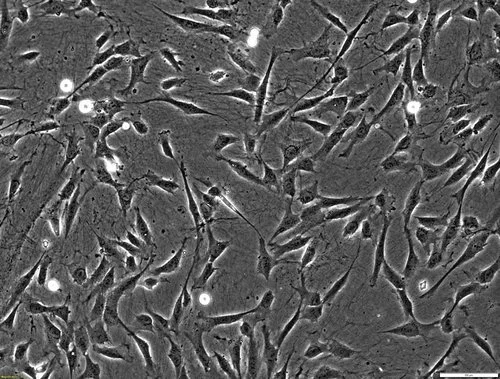CELLvo™ Matrices: Making Cell Culture Relevant
Cell culture is the process of cell growth in a controlled, external (in vitro) environment. Traditional cell culture methodology was established in the early 20th century, and involves isolating cells from a tissue sample and seeding them onto glass or plastic culture dishes.
Unfortunately, once seeded, these cells tend to respond to the environment they're placed in by immediately changing their gene expression. The changes are often so profound that the resultant cells no longer resemble the cells originally sourced from the tissue. This is a significant issue, given that the objective of cell culture is to replicate in vivo cell growth as closely as possible.
Why do the cells change so significantly? Over the last two decades, huge attention has been focused on a cell’s microenvironment and how it regulates stem cell fate. Scientists have explored a number of potential factors, including substrate stiffness, cytokines, cell-cell interactions and morphology.
The Cell - Extracellular Matrix Connection
But perhaps the most interesting work on this subject involves the interactions between cells and their extracellular matrix. To understand why these studies are so compelling, let’s take a step back and examine a cell in its native niche. While cells are historically viewed as the building block of the human body, they actually don’t take up that much space. In fact, far more space is occupied by the local environment surrounding and supporting these cells: a physiologically complex mixture of structural and soluble proteins called the extracellular matrix, or ECM. The cell and its ECM are in constant communication, to the extent that it’s difficult to determine where the cell ends and the ECM begins. But in standard cell culture techniques, a cell’s ECM is generally ignored.
Given the complex interplay of variables in a cell’s microenvironment, this overly reductionist approach to cell culture leads to failure; placing isolated cells on traditional substrates and stripping them of their microenvironment causes them to up-regulate proteins that they expect to see in their native niche (and that are no longer present). In other words, what’s not there is just as important as what is there, and as such shouldn’t be overlooked.
Recent studies in cell-ECM interactions highlight just how poorly traditional cell culture approximates microenvironment, and the need to more closely replicate the cells’ physiological niche.
One Size Doesn’t Fit All
Another important aspect to note is that there are many different niches within the human body, and not all cells require the same niche to grow and behave normally. The matrix that a cell produces is specific to the cell’s source tissue, and that matrix in turn influences the cell in a manner consistent with its source. All the more reason, then, to avoid a cookie-cutter approach to cell culture methodology.
StemBioSys’ CELLvo™ Matrix technology is designed to enable biologically relevant phenotypes by engineering 3D tissue-specific culture systems to replicate the in vivo niche. Our process involves extracting stromal cells from the body and inducing them to secrete a matrix in cell culture dishes, essentially allowing them to grow a thin layer of tissue at the bottom of the dish. These cell-derived matrices create a natural, protein-based environment, leaving the overall structure intact, and the transparent dishes don’t interfere with microscopy.
CELLvo™ matrices are simple, scalable and reproducible. They fit easily into existing workflows, with no changes to seeding density or reagents. And they are compatible with fluorescent imaging and have a more native phenotype. Most importantly, cells in CELLvo™ matrices offer a greater response to experimental stimuli (including better phenotype retention),
Varied Technologies to Meet Different Needs
Our CELLvo™ technology suite consists of several products: CELLvo™ Matrix, CELLvo™ Matrix Plus, CELLvo™ ChondroMatrix and CELLvo™ XF Matrix. Though much of the composition is shared between matrix products, there are certain differences in physical and biochemical properties, as well as in function.
CELLvo™ Matrix is produced by bone-marrow derived mesenchymal stem cells, while Matrix Plus is derived from amniotic fluid-derived stem cells.
CELLvo™ Matrix is collagen-rich relative to Matrix Plus; Matrix Plus is proteoglycan-rich relative to CELLvo™ Matrix. (Proteoglycan is potentially critical to the maturation process, as mutations could affect development of the heart.)
CELLvo™ ChrondroMatrix is a cell-free ECM composed of proteins secreted by human articular chondrocytes (HC-a), thus providing a native microenvironment for the growth and expansion of these particular cells.
CELLvo™ XF Matrix is a xeno-free ECM made of over 150 proteins secreted and assembled by the bone marrow cells during the production of the matrix. It is easily transitioned to translational studies, and provides a 3D environment for rapid expansion of Mesenchymal Stem Cells (MSCs).
We will soon be launching an additional product, CELLvo™ NeuroMatrix, capable of improving the culture of all neuronal cell types.
Located in San Antonio, TX, StemBioSys develops cell culture technologies licensed from The University of Texas Health Science Center, San Antonio. Our work represents the next evolution in stem cell research. For more information about StemBioSys and our patented technology, please contact us.

